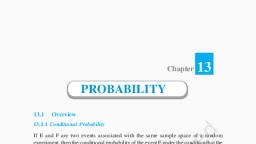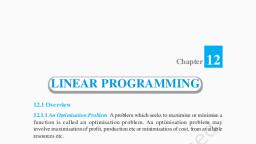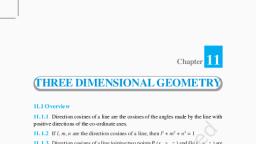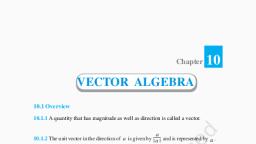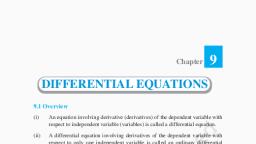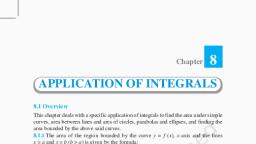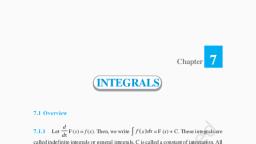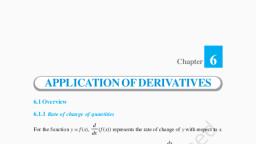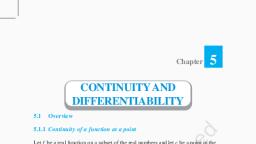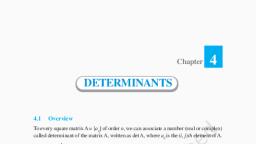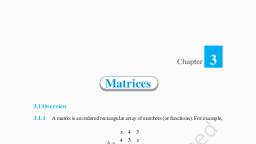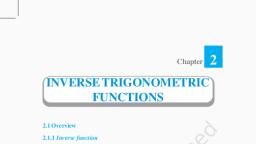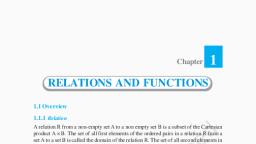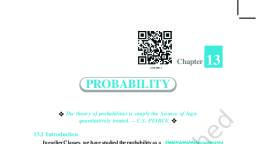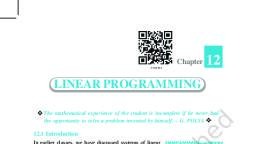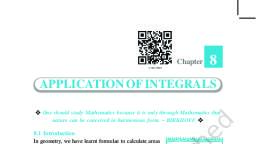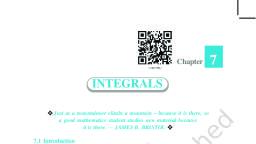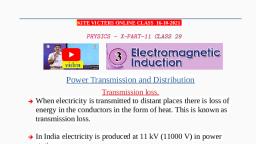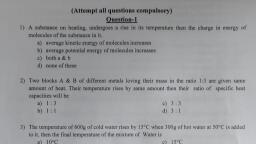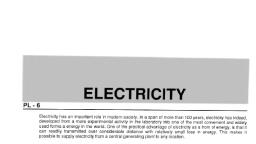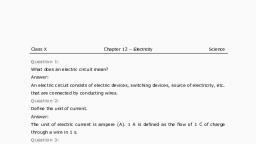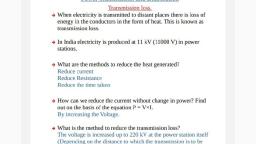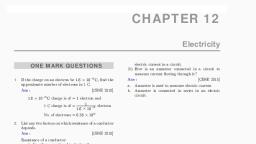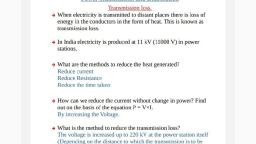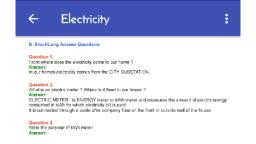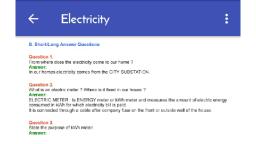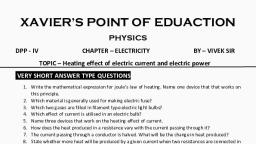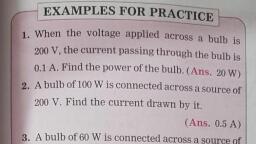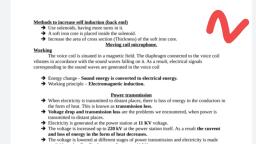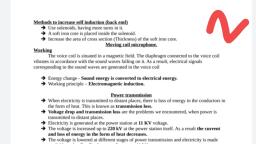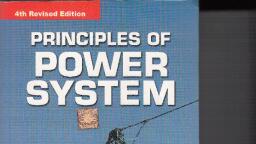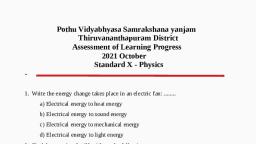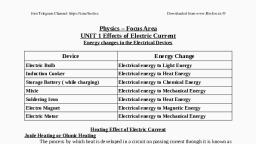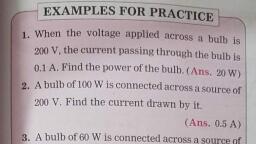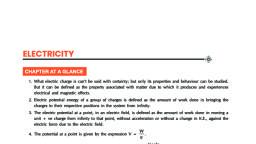Page 1 :
ions, colour coding of wires., , , , , , | Scope of syllabus : House wiring (ring system), power distribution; main circuit (3 wires — live, neutral, earth) with, MCB, main switch and its advantages, circuit diagram, two-way switch, staircase wiring, need for earthing,, 3-pin plug and socket, conventional location of live, neutral and earth points in 3-pin plugs and sockets; safety, , , , , , , , (A) TRANSMISSION OF POWER AND HOUSE WIRING, , , , 9.1 TRANSMISSION OF POWER FROM, THE GENERATING STATION TO THE, CONSUMER, , Electric power is generated at the power, , generating stations which are usually located very, , far from the areas where it is consumed. At the, generating station, the electric power is generated, at 11 kV because generation at voltage higher, than 11 kV causes insulation difficulties, while, generation at voltage lower than 11 kV involves, , a very high current. Since it is not possible to, , step up or step down the d.c. voltage, the voltage, , generated is alternating of frequency 50 Hz, , (i.e., its polarity at the terminals changes, , 100 times a second, 50 times + and 50 times -)., The power from the generating station, , is transmitted to the consumer over the long, , distances not at 11 kV, but at a voltage higher, than 11 kV so as to reduce the loss of energy in, , , , , , , , , , , , BOILER [TURBINE HGENERATORS|, , , , , , , , , , , , , , , , , , ISTATION|, , , , , , , , , , , , form of heat in the line wires used for, transmission., , From relation P = VI, for a given power P,, current J = P/V ie, higher the voltage, lower is, the current. Thus by supplying a given electric, power at a high voltage, the current becomes low, and therefore the loss of energy due to heating, (=FRt) in the line wires becomes less. Thus, the, alternating voltage generated is first stepped up, from 11 kV to 132 kV at the generating station, (or called the grid sub-station) using the step up, transformer. It is then transmitted to the main, sub-station. At the main sub-station, the voltage, is stepped down from 132 kV to 33 kV using the, step down transformer and is then transmitted to, the heavy industries and intermediate sub-station., At the intermediate sub-station, the voltage is, again stepped down from 33 kV to 11 kV using, , , , , , , , , , , , , , , , , , , , , , , , , 33 kV __To HEAVY INDUSTRY, i1kv, 33 kV TO LIGHT, KN TR INDUSTRY, down Steps a, 132 KV to down, down ITY, 33 kV 33 KV to 11 kV CONSUMERS, INTER: T1kV to 20V, MAIN MEDIATE city’, SUB ri SUB, STATION] Searicnl STATON, , , , , , , , , , , , , , , , POWER STATION, , Fig. 9.1 Transmission of electricity from power generating station to the consumers, , 1, , 209, , SS, pets. Secaesbeee at :
Page 2 :
the step down transformer and from here it is, transmitted to light industries and city sub-station., At the city sub-station, it is further stepped down, from 11 kV to 220 V using the step down, transformer to supply it to the domestic, consumers. The transmission of electric, power from the generating station to the consumer, is shown in Fig. 9.1., , Fig. 9.2 shows the simple block diagram of, the transmission of electric power from the, generating station to the consumer., , To heavy industry, , , , , , Power generating, station I, at 11 kV, , Grid sub station), step up, to 132 kV, , Main sub station, |} step down to 33 kV, , AB, , , , , , , , , , , , , , , , , , , , , , , , , , , , , , , , City sub station Intermediate sub station, To 4 step down to step down to 11 kV, consumer 220 V iT, To light industry, Fig. 9.2 Block diagram of transmission of electricity, from power station to the consumer, , 9.2 POWER DISTRIBUTION TO A HOUSE, , To supply the electric power to a house from, the city sub-station, either the overhead wires* or, a cable on poles or an underground cable is used., The cable has three wires : (1) live (or phase), wire (L), (2) neutral wire (N), and (3) earth, wire (E). The neutral and the earth wires are, connected together at the local sub-station so that, the neutral and earth wires are at the same, potential (i.e., at 0 V). The live wire, also called, the phase wire, carries current from the source to, the distribution board, while the neutral wire is, for the return of current to the source., , Before connecting the cable from pole to, the meter in a house, first a fuse of high rating, (= 50 A) is connected in the live wire at the pole, (or just before the meter). This fuse is called the, company fuse (or pole fuse). Only the persons of, * There is usually a set of six wires stretched one above the, other from one pole to the other pole. From the top, their, sequence is : first neutral wire; second, third and fourth the, three phase (or live) wires; fifth the street light live wire and, then sixth the earth wire. The live (or phase) wires are thicker, , than the neutral and earth wires. Live (or phase) wires are, generally made by twisting the several wires together., , the electric supply company are authorised to, handle it. The rating of the fuse depends on the, load for which the connection is taken from the, company. After the company fuse, the cable is, connected to a kWh meter. The kWh meter is, usually mounted on the front (or outside) wall of, the house. From the meter, connections are made, to a main switch (or earth leakage circuit breaker, ELCB) and to a main fuse (or miniature circuit, breaker MCB). The main switch (or ELCB) is, connected in both the live and neutral wires,, while the main fuse (or MCB) is connected only, in the live wire., , The main switch is a double pole switch. It, has an iron covering. The covering is earthed (i.e.,, connected to the earth wire E). The advantage of, using the main switch is that it breaks the, connections of the live as well as the neutral, wires simultaneously from the main supply. The, earth wire from the meter is locally earthed (in, the compound of the liouse). From the distribution, board, the wires go to the different parts of the, house. Now a days a consumer unit is connected, after the kWh meter. This unit contains a double, pole switch or an earth leakage circuit breaker, (ELCB) and MCB for each circuit in the house., , Fig. 9.3 shows the connections from the, electric pole to the distribution box in a house., , , , , , , , kWh meter, , Cara], OO, OO, , , , Company fuse, Cable, , Main switch, , , , , , a, , , , , , , , , , , , , , , , , , , , , , , , Distribution box, Fig. 9.3. Connections by cable from electric pole to, the distribution box, 9.3 HOUSE WIRING (RING SYSTEM), , In a house, the wiring is commonly done by, the ring system. In this system, we have a, separate ring for each portion of the house. In a, portion, the wires starting from the distribution, box run around all the rooms of that portion and, then come back to the distribution box, thus, , ee Oe 20 7 See
Page 3 :
forming a ring. The distribution box contains a, MCB of rating about 30 A. Fig. 9.4 shows a ring, system of wiring connecting a lamp, socket with, switch and fan with regulator., , LAMP SOCKET OUTLET, , , , , , , , , , , , , , , , , , , , , , R, 30A Z FAN, MCB ie, ’ z 3, aaa X-==- fj TO OTHER, E E APPLIANCES, DISTRIBTION BOX, , , , Fig. 9.4 The ring system of house wiring showing circuit for, lamp, socket and fan with fuse and switches in the live wire, , A separate connection is taken for each, appliance from the live wire of the ring. One, terminal of the appliance is connected to the live, wire through a separate fuse and a separate switch,, while the other terminal of the appliance is directly, connected to the neutral wire. The earth terminal, or metal covering of the appliance is connected to, the earth wire. For each appliance, the wires used, for connection should be of proper current carrying, capacity., , Advantages of the ring system : The ring, system has the following four advantages :, , (1) In the ring system, the current from mains, can reach to an individual appliance through, two separate paths. Thus each appliance gets, connected to the mains effectively through a, thick wire. Therefore, the wire required for, main ring is of a lower current carrying, capacity than that which would be required, for a direct connection to the mains. This, considerably reduces the cost of wiring., , (2) Each appliance has a separate fuse. Therefore, , if due to some fault, the fuse of one appliance, , burns, it does not affect the operation of other, appliances., , (3) In this system, all the plugs and sockets used, , can be of same size, but each socket should, , have its own fuse of rating suitable for the, appliances to be connected with it., , (4) While installing a new appliance in a room,, a new line up to the distribution box is not, required, but it can be directly connected to, the ring circuit in that room. The care is taken, that the total current drawn from the mains, in the ring circuit does not exceed the rating, of the main fuse (viz. 30 A)., , Connection of all appliances (bulb, fan,, socket, etic.) with the mains, , We note that all the electrical appliances (say,, bulbs, fans, sockets, etc.) are connected in, parallel with the mains. In the live wire before, each appliance there is a separate switch and a, separate fuse connected in series., , Advantages of connecting the appliances in, parallel, It has the following two main advantages :, (1) Each appliance gets connected to 220 V, supply (= its voltage rating) for its normal, working., Each appliance operates independently, without being affected whether the other, appliances are operated or not., , (2), , Disadvantages of connecting the appliances, in series, , Appliances are not connected in series to the, mains for the following three reasons., , (1) The voltage of the source gets divided in, all the appliances connected in series, in, ratio of their resistances, so each appliance, does not operate at its rated voltage., , On connecting one more appliance in the, same circuit, the resistance of the circuit, will increase. Hence it will reduce the, current in the circuit, so each appliance, will get less power., , All appliances connected in series operate, simultaneously. None of the appliance can, be operated independently. If one, appliance is switched off (or not operated),, no other appliance connected with it in, series will then operate., , (2), , (3), , , , SSS ae, , RR
Page 4 :
1., , 2., , (a), , (b), , How will you connect a bulb and a socket in a, room to the mains ? Draw a labelled diagram in, support of your answer. Use switch and fuse, wherever necessary., , In a room, the bulb and socket are connected in, parallel with the mains as shown in Fig. 9.5 below., , , , Fig. 9.5, , The diagram in Fig. 9.6 shows a battery, a switch, and two bulbs. (a) Complete the diagram to show, the electric connections of the bulbs to the battery., (b) How have you joined the bulbs in part (a) ?, , Give reason., gan Ss, , BLS BATTERY, BULB j, , ———, Fig. 9.6, The completed diagram is shown in Fig. 9.7., , , , Fig. 9.7, , The two bulbs are connected in parallel., , Reason : (1) Both the bulbs glow at the same, voltage. (2) If one bulb ceases to glow, the other, bulb remains glowing., , The diagram in Fig. 9.8 shows the electrical, system of a car to operate the two head lights, and two rear lights by a switch,, , , , , , shows a connection to the body of the car., , , , , SWITCH, , Fig. 9.8, , The diagram shows only one lead from the, battery to each bulb, but a complete circuit must, have two leads. How does the current get back, to the battery ?, , The two rear lights as connected in diagram glow, faintly. Why do they glow faintly ? How should, they be connected to glow brightly ? Show by a, separate diagram., , (iii) If the lights are or, they become dim when the, , car is started. Give ‘a reason., , (i) One lead of the battery and one terminal of the, , appliance (i.e., bulb) is connected to the body, of the car (i.e., to the earth). The current gets, back to the battery through the body of the, car (i.e., earth), Thus the body of the car, behaves like the other lead., , (ii) The two rear lights are connected in series so each, , light glows at half the voltage of the battery (if the, resistance of filament of each bulb is same). Hence, they glow faintly. They must be connected, in parallel to glow properly as shown below in, Fig. 9.9., , , , , , , , , , LUGHTayy,, LG, Va,, REAR LIGHT, , , , Fig. 9.9 "ead LIGHT, , (iii) When the car is started, it draws heavy current, from the battery. The terminal voltage of, the battery falls due to voltage drop. As a result,, , the voltage across each bulb falls and they, become dim., , SS Sa SS 0 Ee eee
Page 5 :
4, An electric bulb rated ‘220 V, 60 W’ glows when, connected with 220 V mains., , (i) Find the resistance of the filament of the, bulb., Another identical bulb is connected in series, with the first one and the system is connected, across the 220 V mains. Draw a diagram to show, the arrangement and find : (a) the rate of, consumption of energy in each bulb, and (ii) total, power consumed., If two bulbs are connected in parallel, draw a, diagram of this arrangement. What will then, be the total power consumed ?, Given : rating of bulb is 220 V, 60 W i.e., voltage, V = 220 volt and power P = 60 watt., (i) Resistance of filament of the bulb, v2 _ (220)?, P= oO, The arrangement of two identical bulbs in series, with the mains is shown in Fig. 9.10. In this, , BULB 1 BULB 2, , (ii), , (iii), , R= = 80667 2, , (ii), , MAINS, , , , 220V, Fig. 9.10, , arrangement voltage across each bulb will be, , V = 110 volt., (a) Rate of consumption of energy in each bulb, Vv? _ doy, = = 30067 = 15 W, , Assuming that the resistance of bulb does not, change on glowing., (b) Total power consumed in the two bulbs, =15W+15W=30W, , (iii) The arrangement of two identical bulbs in, parallel with the mains is shown in Fig. 9.11., In this arrangement, voltage across each bulb, will be V = 220 volt and then power spent in, each bulb will be 60 W., , Total power consumed in the two bulbs, = 60 W + 60 W = 120 W, , BULB 1, , , , BULB 2, , , , , , , , MAINS, Nw, 220V, , , , Fig. 9.11, , , , 1. At what voltage and frequency is the electric power, generated at the power generating station ?, Ans. Voltage — 11 kV, Frequency — 50 Hz, , 2. Explain with the aid of a simple diagram, the, , transmission of electric power from the generating, station to your house., , 3. (a) At what voltage is the electric power from the, generating station transmitted ? Give reason to, your answer., , (b) What is the nature of current transmitted from, the power station ?, , 4. At what (i) voltage and (ii) frequency is the a.c., , supplied to our houses ?, Ans. (i) 220 V, (ii) 50 Hz, , 5. Name the device used to (a) increase the voltage at, , the generating station, and (b) decrease the voltage, at the sub station for its supply., , 6. (a) Name the three connecting wires used in a, household circuit., , , , (b) Which of the two wires mentioned in, part (a) are at the same potential ?, (c) In which of the wire stated in part (a), the, switch is connected ?, 7. What is the pole fuse ? Write down its current rating., 8. State the function of each of the following in a, house circuiting :, (a) kWh meter, (b) main fuse, and (c) main switch., 9. In what unit does the electric meter in a house, measure the electrical energy consumed ? What is its, value in S.I. unit 2? Ans. kWh, 1 kWh = 3-6 x 10°J, Where is the main fuse connected in a house, circuit 2? Ans. In live wire before the ring system., ll. State one advantage of using the main switch in, house wiring., Draw a circuit diagram to explain the ring system of, house wiring. State two advantages of it., Draw a labelled diagram with the necessary switch,, regulator, efc. to connect a bulb and a fan with the, , 10., , 12., , 13., , eee 213 EE Se eae

